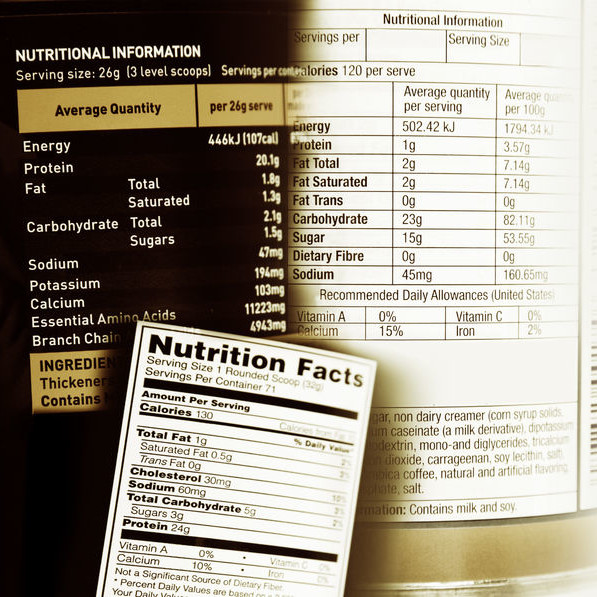
Food Labeling
What is food labeling?
There is an international standard that outlines proper food labeling. It includes:
- Principal display and information panel
- Statement of identity
- Ingredient statement
- Net quantity of contents
- Statement of responsible party
- Nutrition facts
- Claims
- Label warnings
- Education and training
The Food and Agriculture Organization (FAO) defines food labeling as anything that “includes any written, printed, or graphic matter that is present on the label, accompanies the food, or is displayed near the food, including that to promote its sale or disposal.”1
- Tags
- Brands
- Marks
- Pictorial or other descriptive matter
- Written or printed material
- Embossed or impressed on
Food labeling should be easily understood by consumers. Guidelines under Codex Alimentarius state that prepackaged food cannot be labeled in a way that is misleading, false, or deceptive.2 The Codex Alimentarius guidelines state that “packaged food must be labelled with the name of the food, list of ingredients, net contents, name and address of manufacturer, distributor, importer, exporter or vendor, country of origin, lot identification, date marking and storage instructions, instructions for use.”2
Origin
In 1967, the Fair Packaging and Labeling Act was enacted. It requires all consumer food products to be honestly and informatively labeled.3 Before 1960, the only packaged foods were specialized dietary foods. With the increase in food manufacturing in the 1960s, consumers wanted more information about the ingredients in the processed foods they were eating.
Regulatory compliance
Title 21 of the Code of Federal Regulations is where most of the information on food labeling is located.4 Food labeling is regulated by the FDA for manufacturers of packaged food.
Application
All packaged food manufacturers should establish a food labeling program to ensure compliance with federal regulations. Products that do not comply or are in violation of the regulations may be subject to recall. A food labeling program should have the following components:5
1. Principal display and information panels – The principal display panel is the section of the label that is displayed on retail shelves. It is the area most visible to consumers and provides information such as net quantity and identity of the contents. The information panel is to the right of the principal display panel, and contains the nutritional panel, ingredient list, statement of responsible party, and any applicable warnings.5
2. Statement of identity – The statement of identity is the name of the type of food in the package.
3. Ingredient statement – The ingredient statement is a list of all the ingredients used in the product. This is required for all food made with two or more ingredients.
4.Net quantity of contents – This is the amount of material in the packaged food excluding the package. It is listed on the base of the package.
5.Statement of responsible party – The statement of responsible party is located on the principal display panel or on the information panel, after the ingredient statement. The responsible party may be the manufacturer or a distributor.
6. Nutrition facts – The nutrition facts panel must be printed in an easy-to-read format. It is usually printed in black on a white background. It lists the following information:5
- Nutrition facts
- Amount per serving
- % Daily Value
- Calories
- Total fat
- Cholesterol
- Sodium
- Total carbohydrates
- Protein
7. Claims – The FDA regulates claims, and no claim may be made on a package without being approved.
8. Label warnings – Label warnings apply to very specific types of food and how they are packaged or processed. For more information, refer to FDA 21CFR101.17.5
9. Education and training – Labeling activities should be performed by nutritional labeling and regulatory personnel. Implementation of a verification program will ensure you are in compliance. Labels should be inspected upon receipt for proper information after each print run. A written procedure for disposing of labels should be created to prevent use of incorrect labels.5
References
- >Food and Agriculture Organization of the United Nations. “Food Labeling.” Food and Agriculture Organization of the United Nations, 3 Sept. 2013, http://www.fao.org/ag/humannutrition/foodlabel@172033/en/
- The Codex Alimentarius Commission. Food Labeling: Complete Texts, 5th ed., World Health Organization Food and Agriculture Organization of the United Nations, 2007.pp. 1–9.
- U.S. Federal Trade Commission. “Fair Packaging and Labeling Act.” https://www.ftc.gov/enforcement/rules/rulemaking-regulatory-reform-proceedings/fair-packaging-labeling-act.
- U.S. Food and Drug Administration. “21 CFR 117 – Current Good Manufacturing Practice, Hazard Analysis, and Risk-based Preventive Controls for Human Food.” 1 Apr. 2017, https://www.accessdata.fda.gov/scripts/cdrh/cfdocs/cfcfr/cfrsearch.cfm?cfrpart=101
- AIB International. “Labeling Program.” Food Safety and Sanitation Distance Learning Course, Chapter 26.

